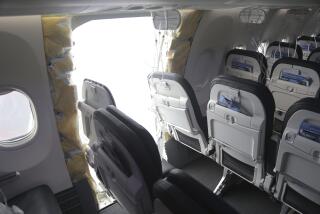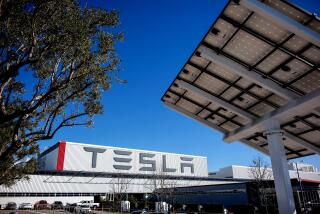Era Ends as Jetliner Takes to the Sky
- Share via
As hundreds of people on the tarmac waved goodbye, Boeing Co.’s last 717 airliner took off Tuesday from Long Beach Airport, marking the end of 90 years of commercial airplane production in Southern California.
The new twin-engine jetliner made for AirTran Airways was the 15,599th commercial or military plane built at the sprawling manufacturing complex at the airport since 1941.
“They’re calling it a celebration, but it feels more like a funeral,” said Alvin Frye, an aircraft inspector who was hired at the plant in 1965.
Frye, 62, was among 3,000 current and former workers who gathered to mark the plant’s last aircraft delivery and relive its storied history. While typical aircraft delivery ceremonies are cheerful and filled with balloons, Tuesday’s occasion was solemn and eerily quiet, except for a stand where employees were briskly selling shirts embossed with 717 logos at half price.
The Long Beach plant, owned by Boeing, was built by Douglas Aircraft Co. and still has a large “Fly DC Jets” sign out front. For decades it thrived, producing some of the world’s most popular airliners, including the DC-3, DC-8 and MD-80.
After the delivery ceremony some spectators stayed to watch the last plane take off, including Jerry Callaghan, who helped design the 717. Callaghan, who is now retired, recalled that he was standing at the same spot a decade ago when he witnessed the first flight of a 717.
He said Tuesday that he felt as if he were seeing his child “go off and leave the nest. This is it. Everything has to come to an end,” Callaghan said as he was hugged by his wife, Joan.
Boeing announced last year that it would close the 717 line because of slow sales of the single-aisle jetliner. It was a plane that Boeing inherited when it acquired McDonnell Douglas Corp. in 1997, but the 717, originally called the MD-95, never caught on with major airlines.
The Long Beach complex was part of Southern California’s golden era of aviation as pioneers took advantage of the temperate climate and lots of open space to test their new flying machines.
In 1916, the Loughhead brothers formed a firm that became Lockheed Aircraft and two decades later built planes for Amelia Earhart. In the ‘20s, Donald Douglas set up his firm behind a Los Angeles barber shop. A few years later a small San Diego firm started by Claude Ryan built the plane that Charles Lindbergh flew across the Atlantic. Other Southland aviation pioneers included Jack Northrop and Howard Hughes, who built companies that bore their names and flourished.
At its peak during World War II, the Douglas Aircraft plant in Long Beach employed 50,000 people and a new plane was completed every two hours. Its prosperity spawned new communities, such as Lakewood, to house workers.
Among the early residents were couples such as Billy and Evelyn Dewees, who attended Tuesday’s ceremony wearing their old McDonnell Douglas employee badges.
Evelyn started working at the Long Beach plant in 1954 building the C-133 and then the C-124 military cargo planes. Billy was hired three years later.
Evelyn’s starting pay was $1.24 an hour, plus a bonus of 8 cents an hour for working the swing shift. That beat the going rate of 80 cents an hour for an office job, she recalled.
“They treated us well,” she said, noting how aerospace helped spawn a middle class in the area. “And we got good pensions, better than most.”
The Deweeses retired in 1989, walking out of the factory holding hands.
Aerospace manufacturing in the Southland peaked in the late 1980s before the end of the Cold War triggered a major retrenchment that led to consolidation of the industry as competition from overseas grew.
“We lost all of that in the early 1990s,” said Joseph Magaddino, head of Cal State Long Beach’s economics department. “Almost half a million [aerospace] jobs were lost in the region.”
With the loss of airliner production, local aircraft manufacturing employment is now about 40,000, down some three-quarters from its peak. Much of the Southland’s aerospace work has shifted to military research and development.
One reason for the 717’s demise was that its cockpit configuration is different from that of other planes in Boeing’s family of jetliners. Some former 717 workers lamented Tuesday that the plane never got the marketing support to make it successful. In all, 156 of the 717s were built, short of the 200 Boeing said would need to be sold for the plane to be deemed profitable.
About 1,800 people worked on the 717 assembly line five years ago, but only 160 were left to build the last of the planes. At least one hangar is likely to stay open for 717 maintenance work and will employ a skeletal crew.
Some workers on the 717 assembly line retired, while others such as Frye were shifted to another Boeing factory in Long Beach that builds C-17 transport planes. But that facility will be closed in 2008 unless the Air Force orders additional planes.
Although jetliners will no longer be assembled in Southern California, it is still home to thousands of suppliers that make parts for Boeing and Europe’s Airbus, the only two makers of big commercial airliners. The region also remains the site of the nation’s top advanced aerospace research and development firms, which design satellites, rockets and robotic planes.
At Lockheed Martin Corp.’s famed “Skunkworks” in Palmdale, for example, more than 4,000 engineers work on top-secret aircraft programs.
And Torrance is still home to the nation’s largest helicopter maker, Robinson Helicopter Co.
But for many longtime residents, Tuesday’s 717 ceremony marked the end of an era. A large section of the Boeing complex in Long Beach has already been bulldozed to make room for homes and offices.
“We’ve lived here for 55 years and to see all of that disappear is very sad,” Evelyn Dewees said. “It’s like losing a child.”
More to Read
Inside the business of entertainment
The Wide Shot brings you news, analysis and insights on everything from streaming wars to production — and what it all means for the future.
You may occasionally receive promotional content from the Los Angeles Times.










